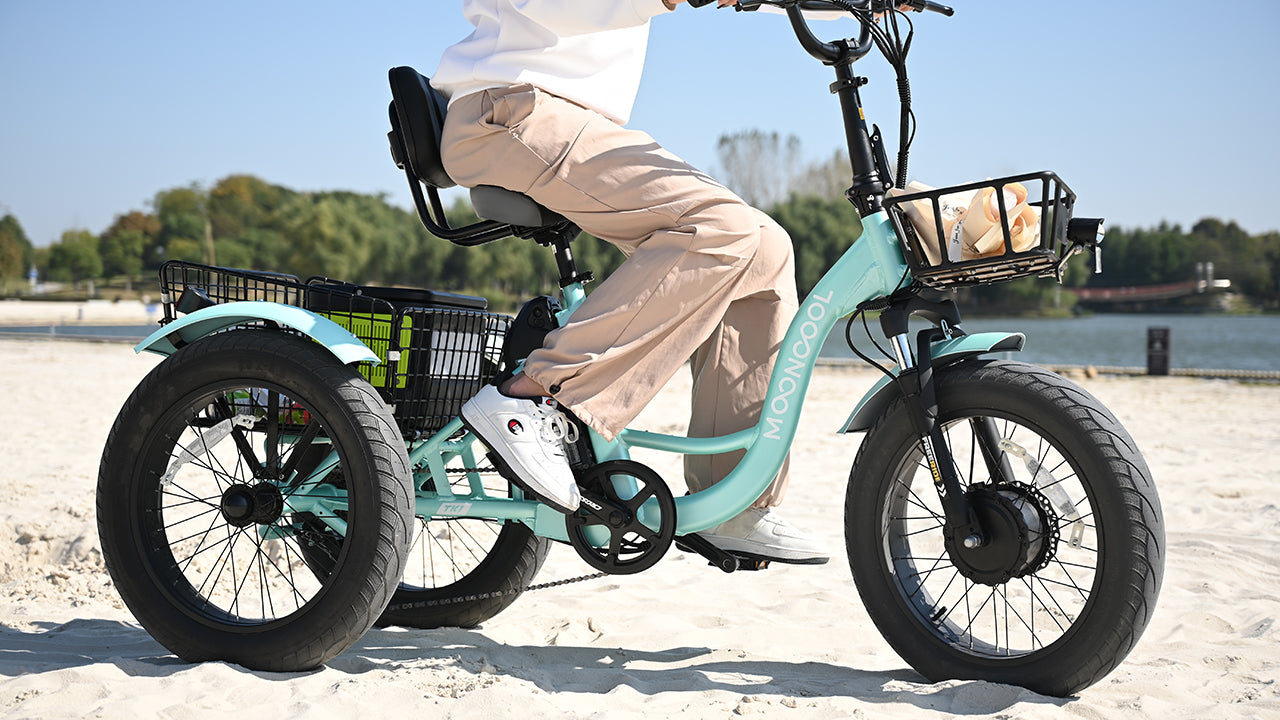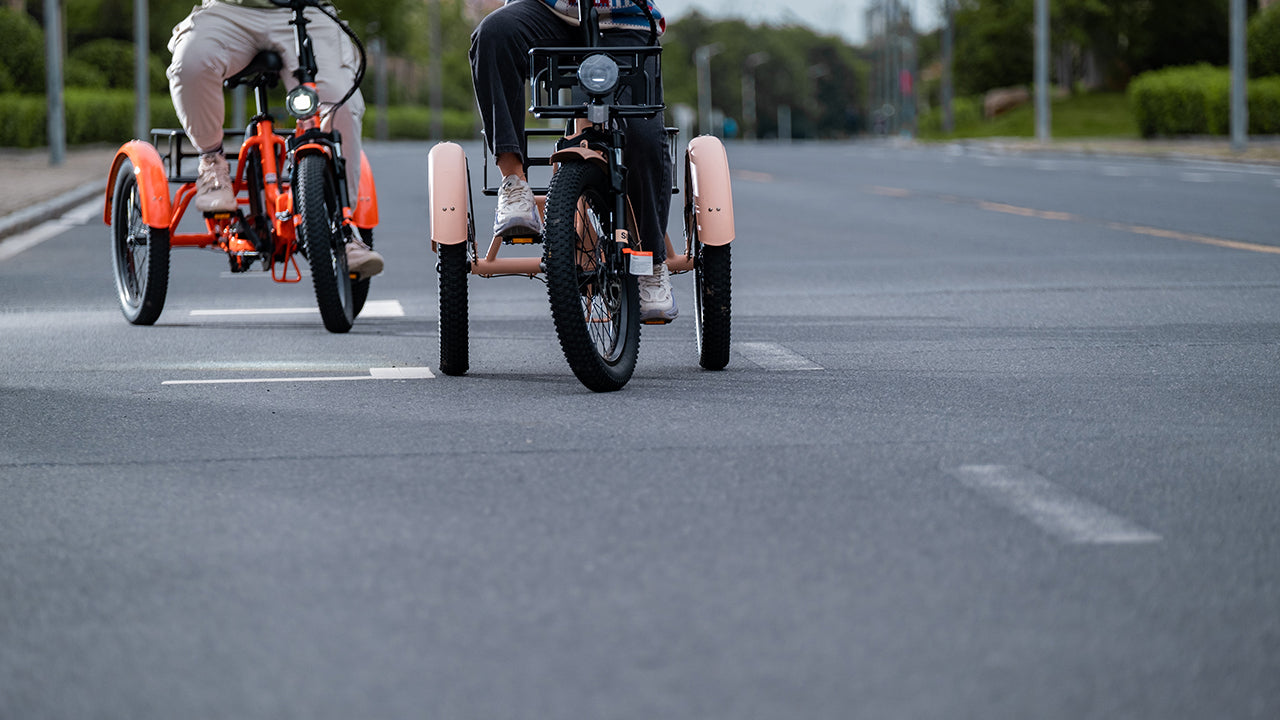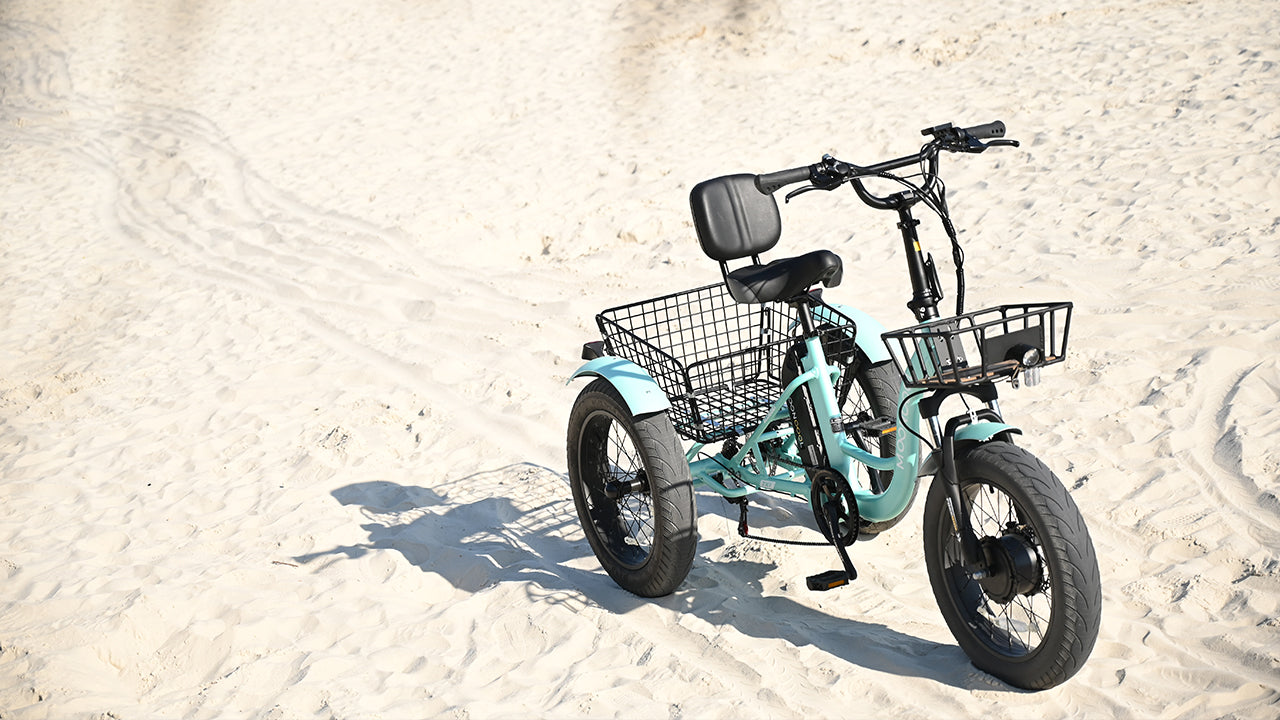| Feature | Pedal Assist | Throttle |
|---|---|---|
| How it works | Motor helps when you pedal | Control speed with twist grip |
| Pedaling needed? | Yes | No |
| Feel | Natural, like riding a bike | Full control like motorcycle |
| Exercise | More exercise | Less exercise |
| Cost | Cheaper | More expensive |
Electric tricycles, or e-trikes, add a motorized boost to the classic three-wheeled cycling experience. Today's e-trikes electric tricycles come in all shapes and sizes. But one thing they share is the ability to give your pedaling a helpful nudge with electric assistance.
The two main types of electric assist controls are pedal assist and throttle operation. How do they work? What's the difference? Understanding the distinctions is key to picking the e trikes for adults that fits your style and needs. In this guide, we'll break down the characteristics of pedal assist versus throttle systems to help you decide which is right for you.

What are Pedal Assist and Throttle Controls?
Pedal assist and throttle control are the two main types of electric assist systems found on e trike for sale.
Pedal Assist
Pedal assist is an electric assist that detects your pedaling and adds proportional power to make pedaling easier. It uses sensors to monitor your pedaling cadence and force. The motor provides assistance as you pedal, like having a helpful tailwind. But it cuts off if you stop pedaling.
Throttle Control
Throttle control is like a motorcycle accelerator. It lets you directly control the motor's output by twisting a grip throttle. The throttle provides power on demand, so you can use the motor without pedaling at all. On most e-trikes for adults, throttle operation is fully independent of pedaling.
In summary:
- The pedal assist aids your pedaling effort, cutting out when pedaling stops.
- Throttle control allows direct control of motor power, independent of pedaling.
How Pedal-Assist Trikes Work
Pedal assist systems rely on sensors that monitor your pedaling in real-time. Most often, pedal assist uses a cadence sensor, torque sensor, or both.
Pedaling Sensors - Cadence and Torque
Cadence sensors track the speed at which you are pedaling, measured in revolutions per minute (RPM). The motor output adjusts based on keeping your cadence within a certain range. Pedaling faster or slower will change the level of assistance.
Torque sensors measure the rotating force you apply to the pedals. More force equals more assistance from the motor. Torque-sensing delivers power proportional to the actual effort you are exerting.
Advanced Algorithms for Natural Feel
Combined sensor systems utilize both cadence and torque tracking to provide nuanced pedal assist response. This allows the most natural and customized feel, coming closest to mimicking an ideal riding experience.
Multiple Assist Modes of E-tricycles
Pedal assist systems also offer different assistance modes that can alter the amount of power delivered:
- Eco or Low mode provides lighter assistance for maximizing range and efficiency.
- Tour, Moderate, or Normal Mode delivers moderate assistance, perfect for everyday riding.
- Sport or High Mode amps up the power for a brisk boost.
- Turbo or Boost Mode provides maximum assist, making pedaling effortless.
The pedal assist is integrated with the e bike trike's control system. Sensors, processors, and motors work seamlessly together to create a smooth experience. More advanced systems feel incredibly natural, responding instantly to changes in your pedaling.

How Throttle-Controlled Trikes Work
1. Intuitive Throttle Control
The throttle grip gives you precise command of e-trike speed, similar to a motorcycle. Gently twist the grip to accelerate smoothly. Keep twisting to increase speed gradually. Easing off the grip will slow the trike down smoothly. This variable throttle control allows subtle or aggressive speed changes. Partial throttle gently speeds up the trike, while full throttle unleashes maximum motor power for brisk acceleration up to the trike's top speed. This intuitive control makes operating the e-trike simple and natural.
2. Pedaling Is Optional
Most throttle-controlled e-trikes allow completely throttle-only operation with no pedaling required. Advanced electronics allow the motor to be controlled solely by the throttle. It enables people with disabilities or injuries limiting pedal motion to ride independently. Riders can also use throttle-only when hauling cargo or tired from a long ride. Throttle mode lets upright and recumbent trike riders maintain a comfortable cruising speed without pedaling fatigue.
3. Customized Throttle Response
Advanced throttles have programmable electronics to customize settings like max speed, acceleration rate, sensitivity, and torque output. For example, acceleration can be tuned from gentle to aggressive. Top speed can be limited as desired. Throttle programming tailors response to both local regulations and personal needs. This provides intuitive handling with the right throttle control flexibility.
4. Increased Independence
The throttle enables summoning motor power on demand with a simple twist. Riders conserve energy and avoid fatigue while maintaining speed. By providing control over pedal and motor power, throttles enhance flexibility, accessibility, and freedom. Riders can tackle routes at their chosen speed and manage exertion as desired.
Comparing Pedal Assist and Throttle Control
While pedal assist and throttle systems both provide motor power assistance on e-trikes, they differ across several facets of design and performance:
Operation
- Pedal Assist requires active rider pedaling input to activate the motor. Sensors detect cadence and torque to provide proportional assistance.
- Throttle systems allow completely on-demand power with no pedaling required. The rider has full control via a twist grip or lever.
Assistance Level
- Pedal assist provides dynamic power output matched to the rider's real-time pedaling force and cadence.
- Throttle systems give the rider variable speed control from zero to full power. The assistance level depends entirely on throttle input.
Riding Experience
- Pedal assist promotes an active riding style, providing moderate exercise to sustain fitness levels. The synchronized assistance makes long rides easier.
- Throttles minimize physical exertion when desired, enabling rest and conserving energy. This allows riding independence regardless of pedaling ability.
Legal Classification
- Pedal assist e-trikes are often legally classified as bicycles due to the required pedaling. They have access to bike paths.
- Throttle e-trikes may require moped registration depending on motor size and max speed capabilities. Regulations vary regionally.
Control Style
- Pedal assist aims to mimic a natural riding feel through responsive sensor-based power delivery. It offers a seamless cycling experience.
- Throttles provide complete user control over speed and assistance. This enables maximum independence and versatility in riding.
Cost Differences
- Basic cadence-sensing pedal assist systems are relatively inexpensive to add to e-trikes.
- More advanced torque-sensing systems and robust throttle mechanisms can substantially increase e-trike costs.
When selecting between systems, riders should consider their needs, riding style, abilities, and budget. Test rides can help ascertain which provides the optimal blend of control and assistance.

How to Choose the Right E Wheels Trike Control System
So, which is the better choice - pedal-assist or throttle control? The answer depends on your individual riding needs:
- If you enjoy cycling for exercise but want a little electric help, pedal assistis likely the best fit. The workout flexibility keeps riding fun while cutting down on fatigue.
- For riders with limited pedaling ability, whether from injury, disability, or poor fitness, a throttle-controlled e-trikeremoves the need to pedal while enabling full independence and range.
- If your priorities are convenience and versatility in getting around town, a throttleallows you to use motor power whenever needed while retaining the option to pedal for exercise.
- For longer recreational excursions out of the city, pedal assistallows you to pedal as much as desired while reserving a battery for the full journey.
The ideal selection comes down to your riding style, intended usage, physical ability, and personal preference. If possible, test riding trikes with each control system is the best way to determine what feels right for your needs. Most riders will get used to either pedal-assist or throttle controls with a little practice.
Key Takeaways on E Trike Bike Controls
When choosing an electric tricycle, understanding the differences between pedal assist and throttle control gives you the knowledge to select the best system for your riding style and needs:
- The pedal assist promotes an active riding experience by amplifying your pedaling effort. The throttle enables on-demand power with minimal or no pedaling required.
- Test rides can help determine which control method provides the right combination of pedaling flexibility and electric power that suits you best.
- Consider your intended usage, riding needs, abilities, and preferences when deciding between pedal-assist or throttle control.
- Both systems have advantages and benefits depending on the rider. There is no universally superior choice, only the e-trike controller that works best for you.
More safety tips to know: Safety Tips for Buying Electric Trikes: Choose the Best with Confidence!
With an awareness of the options available, you can shop for an electric trike confident that your control system selection will enhance the overall riding experience. Let the open road or urban jungle await! An e-trike equipped with your preferred assist method promises fresh air, sights, and adventure.
Read More About E-Trike:
- Safety Tips for Buying Electric Trikes: Choose the Best with Confidenc
- What Is the Lifespan of Electric Trikes for Adults? (2023 Updated!)
- Electric Trikes vs. Traditional Trikes: Which Is Better for You?
- Florida E-Trike Laws: Operational Tips & Safety Rules (2023)
- Fat Tire E-Trikes Conquer All Terrain With Stability and Power




Leave a Comment
This site is protected by hCaptcha and the hCaptcha Privacy Policy and Terms of Service apply.